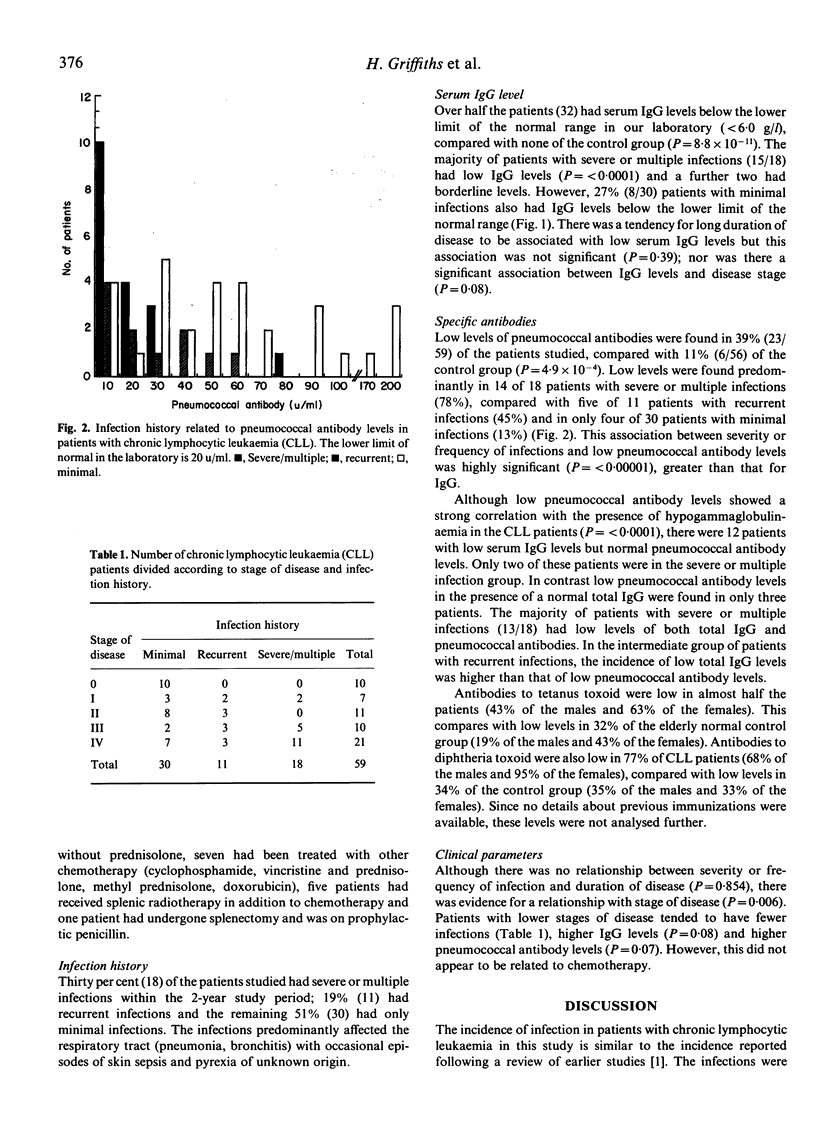Abstract
A group of patients with chronic lymphocytic leukaemia (CLL) were studied to determine whether particular clinical and laboratory parameters might help to identify those patients at risk of recurrent infection who would benefit from immunoglobulin replacement therapy. The case notes of 59 patients were reviewed with regard to stage and duration of disease, chemotherapy and frequency of infection over the preceding 2 years. Serum IgG levels and specific antibodies to tetanus, diphtheria and pneumococcal capsular polysaccharide were measured at the end of the 2-year period. A group of 56 healthy age-matched volunteers were used as controls. Eighteen patients had severe or multiple infections during the study period, 11 patients had recurrent infections and the remaining 30 patients had only minimal infections. Overall, serum IgG levels were low in 32 patients but in none of the control group (P = 8.8 x 10(-11). However, less than half of those patients with hypogammaglobulinaemia suffered from severe or multiple infections. Specific antibodies to pneumococcal capsular polysaccharide were low in 23 patients compared with six of the control group (P = 4.9 x 10(-4)). The majority of patients with severe or multiple infections (13/18) had low levels of both total IgG and specific antibodies to pneumococcal capsular polysaccharide. However, in the groups of patients with less frequent infections, a higher proportion had low serum IgG than low pneumococcal antibody levels. Low levels of pneumococcal antibodies were particularly associated with severe or multiple infections (P = less than 0.00001).
Full text
PDF



Selected References
These references are in PubMed. This may not be the complete list of references from this article.
- Besa E. C., Klumpe D. Prophylactic immune globulin in chronic lymphocytic leukemia. N Engl J Med. 1992 Jan 9;326(2):139–139. doi: 10.1056/NEJM199201093260216. [DOI] [PubMed] [Google Scholar]
- Chapel H. M., Bunch C. Mechanisms of infection in chronic lymphocytic leukemia. Semin Hematol. 1987 Oct;24(4):291–296. [PubMed] [Google Scholar]
- FAIRLEY G. H., SCOTT R. B. Hypogammaglobulinaemia in chronic lymphatic leukaemia. Br Med J. 1961 Oct 7;2(5257):920–924. doi: 10.1136/bmj.2.5257.920. [DOI] [PMC free article] [PubMed] [Google Scholar]
- Griffiths H., Brennan V., Lea J., Bunch C., Lee M., Chapel H. Crossover study of immunoglobulin replacement therapy in patients with low-grade B-cell tumors. Blood. 1989 Feb;73(2):366–368. [PubMed] [Google Scholar]
- Halsey N., Galazka A. The efficacy of DPT and oral poliomyelitis immunization schedules initiated from birth to 12 weeks of age. Bull World Health Organ. 1985;63(6):1151–1169. [PMC free article] [PubMed] [Google Scholar]
- Melville-Smith M., Balfour A. Estimation of Corynebacterium diphtheriae antitoxin in human sera: a comparison of an enzyme-linked immunosorbent assay with the toxin neutralisation test. J Med Microbiol. 1988 Apr;25(4):279–283. doi: 10.1099/00222615-25-4-279. [DOI] [PubMed] [Google Scholar]
- Rai K. R., Montserrat E. Prognostic factors in chronic lymphocytic leukemia. Semin Hematol. 1987 Oct;24(4):252–256. [PubMed] [Google Scholar]
- Rai K. R., Sawitsky A., Cronkite E. P., Chanana A. D., Levy R. N., Pasternack B. S. Clinical staging of chronic lymphocytic leukemia. Blood. 1975 Aug;46(2):219–234. [PubMed] [Google Scholar]
- Weeks J. C., Tierney M. R., Weinstein M. C. Cost effectiveness of prophylactic intravenous immune globulin in chronic lymphocytic leukemia. N Engl J Med. 1991 Jul 11;325(2):81–86. doi: 10.1056/NEJM199107113250202. [DOI] [PubMed] [Google Scholar]


